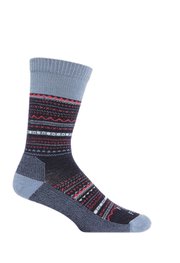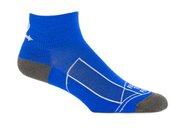BUSINESS SHIFT: Founded in 1993, Nester Hosiery started as a contract knitter, but, as the U.S. sock business began moving offshore, Nester Hosiery shifted its business model. Today, the company produces 7.5 million pairs of socks annually for sale to bricks-and-mortar and online retailers.
COMPANY PROFILE
Nester Hosiery: Diving into the U.S. Supply Chain Feet First
A North Carolina sock manufacturer has fully embraced the “made in USA” trend and has taken it to the ultimate level. The company, Nester Hosiery, based in the textile region of Surry County, N.C., has achieved considerable success with its U.S.-centric supply chain.
The made-in-USA aspect of the company’s socks has helped boost sales through the years with consumers and retailers. About three years ago, Nester Hosiery took it a step further with the launch of its Farm to Feet sock brand.
“It’s working well,” said company founder Marty Nester. “We are now in more than 60 retail stores that cover 40 states. “We are a U.S. company and teamed up with U.S. suppliers of all the raw materials. It’s a 100 percent U.S. recipe. It took us a while to get there with not only the yarns but also the packing, dyes and every aspect.”
The Farm to Feet supply chain begins with American Sheep Industry ranchers, a federation of 45 state sheep associations representing more than 82,000 sheep producers throughout the U.S. Using ASI wool ensures that Farm to Feet socks are made of U.S.-produced merino wool.
From there the wool goes to the Chargeurs facility in Jamestown, S.C., where it is scoured, combed, sorted and prepared for spinning as wool top. From there, the wool top is trucked about 140 miles north to Burlington Industries’ spinning and finishing plant in Raeford, N.C., where it is spun and dyed. It is then shipped about 150 miles northwest to Nester Hosiery, where the company produces Farm to Feet socks from the wool yarn.
Socks are either 100 percent wool or wool blended with small percentages of nylon and spandex, both made in the U.S. Nester sources nylon-covered elastic yarns from McMichael Mills in Madison, N.C. The American-made supply chain continues with a packaging company and a manufacturer of point-of-purchase displays, both made in North Carolina. Even the inks used for the packaging are U.S.-made.
Nester Hosiery’s domestic production is highlighted on the packaging. Each package contains a photo of someone who works along the U.S. supply chain.
The socks are available at many traditional and online retailers of outdoor apparel and range in retail price from $15 to $28 per pair. Nester Hosiery also makes socks for about 20 other brands.
Strategy shift
After 20 years working at some of North Carolina’s major hosiery companies, Marty Nester realized he had the skills and knowledge needed to open his own company. So, he founded Nester Hosiery in 1993.
At first, the new sock maker served as a contract knitter for other hosiery mills and offered no direct sales to retailers. For the first two years, as Nester says, “all we did was knit.” That began to change in 1995 as U.S. sock makers began to lose market share to offshore manufacturers. Nester Hosiery lost about half its sales in one year due to closings of other mills. That led to a rethinking of the company’s long-range strategy.
“We thought it was time to change our customer base a bit and go after retailers,” Nester recalls.
So, Nester Hosiery moved into production of heavyweight, wool and wool-blend outdoor-type socks, and Marty Nester hit the road, calling on some of the major outdoor retailers. He hired nephew Kelly Nester to head up sales. He is now president of the company.
“It took us five to six years before we could end our contract knitting and sell 100 percent of what we made to retailers,” Nester recalls.
Today Nester Hosiery is a thriving manufacturer. It has grown rapidly and now produces 7.5 million pairs of socks annually. About 195 people work at Nester Hosiery. The addition of new machinery in recent years has reduced the total number of repetitive-motion jobs in the plant.
Sustainable, efficient
Sustainability is a major focus for Nester Hosiery, which began measuring its efforts in waste reduction in 2009. The company is now recycling 85 percent of the waste that used to go into a landfill. Water use has been reduced by 40 percent. New air compressors and energy-efficient finishing equipment have allowed the company to trim its energy costs.
“It is something we are proud of,” Nester says. “We try to keep involved in all aspects of sustainability and with our suppliers as well.”
The sustainability aspect of the company’s operations is an important feature for many of its outdoor-apparel customers, such as Patagonia, which touts the Nester Hosiery sustainability story on its website.
Two designers and three knitting technicians handle most of the company’s product development. Business is strong for Nester Hosiery, and its founder believes that pace will continue for the foreseeable future.
“We are ahead of our 2014 goals in terms of sales, revenue and inventory control,” Nester said. “Looking into 2015, everything we hear from our retailers is positive. We are looking at at least 10 percent annual growth this year and the same for 2015.”
























